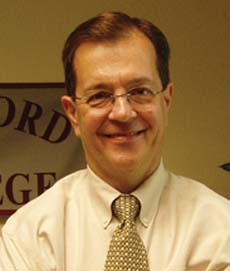On April 6 Guilford President Kent Chabotar pushed his strategic long-range plan forward another step as he addressed students, faculty and community members in a town-hall-style meeting. “Rather than listen to anecdotes, rumors, and myths,” said Chabotar, “we’re going to listen to facts.”
Three additional documents support the strategic plan: the long-range financial plan, the campus master plan, and the campaign feasibility study.
The long-range financial plan is already finished. It addresses the fiscal aspects and implications of the strategic plan, such as where the college’s money is going to be spent. The campus master plan focuses on how both the land and the buildings of the campus are used. The campaign feasibility study analyzes who would be willing to donate money and how much they would be willing to give.
According to Chabotar, the long-range plan is already underway. Next year, the college is admitting fewer students and hiring more teachers.
In addition there will be a 99-person waiting list next year. In the past seven years, the college has had a waiting list four times. Of those four times, the list topped double digits only once.
More important than the plan is the current Southern Association of Colleges and Schools (SACS) reaffirmation of accreditation process.
“The reaccredidation process is the most important thing. If we’re not accredited, the long-range plan doesn’t matter,” Chabotar said. “We may have to slow the plan down, but SACS takes priority.”
It was clear to members of the audience that Chabotar emphasized the importance of community and community space, which is why he feels the campus master plan is so important.
“The fact that (Chabotar) has a vision and that he is moving the college forward is something we desperately need,” said first-year professor Eric Mortenson. “I trust him and I’m on board. I trust his values and his priorities.”
Chabotar went on to discuss the importance of community participation and input in the master plan before turning the discussion over to Mike Van Yahres of Van Yahres Associates, an independent contracting firm that specializes in campus master planning. Van Yahres covered the importance of creating a campus master plan and the steps taken to do so.
“A campus is far more than just the space between buildings,” he said. “It should be a blend of fine architecture in a park-like setting.”
Forging a campus master plan is a five-step process according to Van Yahres.
Guilford is currently in the first stage, the project start-up phase. It involves several information meetings open to all members of the community and early assessment steps such as examining exactly what the college currently has at its disposal.
The second phase expands on the information gathering, with more community input and town-hall meetings.
Van Yahres referred to the third phase as the engagement phase. Here, Van Yahres Associates gains a deeper, more detailed understanding of the campus, the buildings, and their potential.
This means that buildings are analyzed to see how many offices and classes they can hold. The campus is also analyzed to see where expansion can take place. The firm then shares this information with college administrators.
The fourth phase is scheduled to take place this summer and will entail generation of concrete ideas by Van Yahres Associates. These ideas will be put to more discussion the following fall.
The last phase is implementation, where the college agrees on concrete decisions and begins their implementation.
“Money comes and goes. Trustees come and go. Students come and go. Administrators come and go. Knowledge and research in this electronic age are exported in the blink of an eye. Faculty come and go,” said Van Yahres. “The campus itself is the only thing besides the institution’s reputation that really stays put. That’s why this master planning is so important.”
For such an important event, there were few traditional students to be seen.
“Honestly, I hear a lot of people complaining about what’s happening at Guilford,” said sophomore Nick Boylan. “But if students don’t go to these meetings, they don’t know what’s really happening, why it’s happening, or who to complain to.

